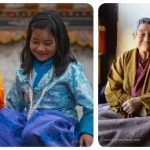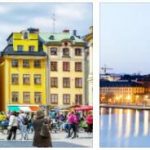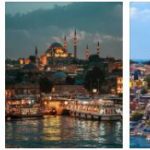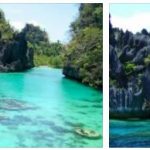The capital of Bhutan – the city of Thimphu is located in the western part of the country in a mountain valley at an altitude of 2700 m. In historical sources, it was first mentioned under the 2nd century AD. Thimphu has been the capital of Bhutansince 1961.
According to Top-mba-universities, Bhutan.all buildings in the city are made in the style of traditional architecture. In the central part of the city on a high hill stands the monastery of Trashi-Chho-Dzong (“Fortress of the Blessed Religion”) – the largest monastery in Bhutan and the religious center of the country. The government of Bhutan, the royal throne room are located here, and in the summer the jokempo (religious leader of Bhutan) moves here) with 2000 monks. South of Trashi-Cho-Dzong are the National Institute of Zorig-Chusum (known as the Royal School of Art), the National Library with a collection of ancient manuscripts in Tibetan languages and the Dzongkha language, the National Institute of Traditional Medicine (one of the largest in the Himalayas), the National Textile a museum, the Changangha Laghang temple, the Dechen Podrang religious school, a TV tower with a beautiful view of the whole city, the Motitang Taking nature reserve, equipped in the form of a small zoo, and an extensive city market that works on weekends.
In the vicinity of Thimphu, the most ancient fortified monastery of the country – Simtokha Dzong (1627) – and the monasteries of Phajoding, Sulukha Dzong and Cheri are interesting.
Neighborhood Thimphu with picturesque mountains and dense forests are perfect for hiking. The best place for hiking is Jigme Dorji National Park, named after the third king of Bhutan. This is the largest protected area in Bhutan, the area of the park is 4329 square meters. km. There are more than 30 species of mammals, about 300 species of birds and 1400 species of plants. There are many hiking trails of various difficulty levels in the park.
To the west of Thimphu is one of the most beautiful valleys in the country – the sacred Paro Valley, where the city of the same name is located at an altitude of 2400 m. In the city of Paro Bhutan ‘s only international airport is located, for which it was called the country’s air gate. Along the central city street, you can see many buildings made in the traditional style. The main attraction of the city is the 16th century Paro Dzong Monastery, which is dominated by an old tower from the 17th century, which houses the Ta Dzog National Museum.
Tourists go to Paro in order to look at the monastery located 10 km north of it Taksang-Lahang-Dzong, which means “Tiger’s Lair”. This is one of the main Buddhist shrines of the country, because the monastery was founded by Guru Rimpoche (Padmasambhava), who is considered the founder of Buddhism in Bhutan. The appearance of the monastery on the top of the rocky cliff dates back to the 8th century, when, according to legend, Guru Rimpoche was transferred to one of the local caves for meditation. Many tourists prefer to get here along the hiking trails laid on the rocks. This trip can take up to 5 hours. The best time to visit the monastery is during the annual Tsechu Festival, which takes place in March-April.
In the Paro Valley, it is also worth visiting the ruins of the fortified Druk Yul Dzong (“Fortress of Victory”) monastery (17th century) and the monastery of Kuichyu Laghang – one of 108 monasteries that were built in the 7th century under King Songtsen Gampo of Tibet in one night for protection Tibet from evil spirits.
In addition to sacred sites, the Paro Valley is famous for its picturesque landscapes, which can be viewed while hiking or cycling. On a clear day, from here you can see the sacred mountain Chomolgari (7314 m), located on the northwestern borders of Bhutan, where, according to legend, the symbol of Bhutan, the thunder dragon, lives.
From Paro, you can also go to the southwest of the country to the Haa Valley, where on an area of 644 square meters. km stretches Torsa Reserve. The reserve is occupied by temperate forests and alpine meadows. Many birds live here, among which are forest partridges, forest snipes and a rare Nepalese kalao.
To the east of Thimphu, through the Dochu-La mountain pass (3116 m), a highway was laid to the ancient capital of Bhutan – the city of Punakha . Punakha is located in a fertile valley at an altitude of 1220 m. The climate here is subtropical, which allows the cultivation of many crops. From the 17th century until the second half of the 20th century, Punakha was the capital of Bhutan., and to this day, because of its mild climate, the city is called the “winter capital” of the country; in winter, the spiritual leader, the jokempo, moves to Punakha. The city was founded in 1637 at the confluence of the Mo-Chu and Pho-Chu rivers by the fortified monastery Pungthang-Dechen-Phodrang-Dzong (Palace of Great Happiness), now known as Punakha Dzong. It was one of the first dzongs erected under King Shabdrung, and he was buried here.
The surroundings of Punakha are dotted with hiking trails of various levels of difficulty. The most popular routes pass through the Guru Rinpoche caves, inside one of which a small temple is built, and the Koma-Tsachu hot springs, from which water is supplied to three pools.
South of Punakha, on the banks of the Punakha-Chu River, is the city of Wangdi. In its vicinity, it is worth visiting the Wangdiphodrang Dzong monastery complex (1638), the Gangte monastery (17th century), the Landra Nie caves (“the sacred place of the red bull”), where, according to legend, Guru Rinpoche meditated and where his fingerprint was preserved, as well as the Phobjikha Valley in the Black Mountains, where Black-necked Cranes winter.
The Phobjikha Valley is located on the territory of the Black Mountains National Park, which separates the eastern and western parts of Bhutan.. The park is home to such mammals as Himalayan bears, Bengal tigers, clouded leopards, red pandas, gorals, Indian sambars, musk deer, golden langurs, as well as more than 300 species of birds. The Royal Manas National Park borders the Black Mountains National Park. The park was founded in 1966 and became the country’s first national park. It is occupied by tropical and subtropical ecosystems with tropical rainforests. In the rainy season, up to 5000 mm of precipitation falls here. Due to similar climatic conditions, this park is the richest protected area in Bhutan. Also in the southern part of the country, the Phibsoo reserve with an area of 278 square meters is interesting. km, where the only ones in Bhutan are protected massifs of sal forests.
In the very center of Bhutan, in the valley of the Mangde Chu River, at an altitude of 2000 m, the ancient city of Tongsa is located – the family nest of the ruling Wangchuk dynasty, which came to power in 1907. It was here that the ancestors of the current king lived. The center of the valley is the imposing fortress of Tongsa Dzong – one of the largest fortresses in Bhutan. Tongsa Dzong is a link between the West and East of Bhutan, the historical core of state power, which concentrated all regions of the country. The best time to visit the fortress is November-December, when the traditional Tongsa Tsechu festival is held here.
East central Bhutan at altitudes from 2600 to 4000 m, the Bumthang Dzongkhag stretches. Bumthang is the ancient spiritual center of the country, the place from where Buddhism spread to the entire territory of the state. In the local valleys there are many sacred places associated with the name of the great teacher Guru Rimpoche. Bumthang is also known for its picturesque nature, extensive apple orchards and multi-colored woven panels “yatra”, which are made from sheep’s wool.









